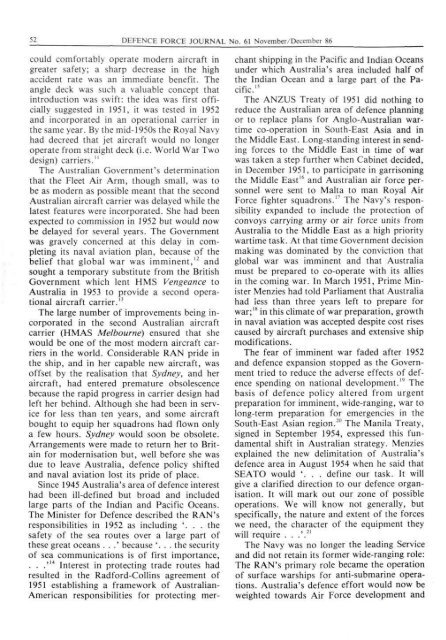ISSUE 61 : Nov/Dec - 1986 - Australian Defence Force Journal
ISSUE 61 : Nov/Dec - 1986 - Australian Defence Force Journal
ISSUE 61 : Nov/Dec - 1986 - Australian Defence Force Journal
You also want an ePaper? Increase the reach of your titles
YUMPU automatically turns print PDFs into web optimized ePapers that Google loves.
52 DEFENCE FORCE JOURNAL No. <strong>61</strong> <strong>Nov</strong>ember/<strong>Dec</strong>ember 86<br />
could comfortably operate modern aircraft in<br />
greater safety; a sharp decrease in the high<br />
accident rate was an immediate benefit. The<br />
angle deck was such a valuable concept that<br />
introduction was swift: the idea was first officially<br />
suggested in 1951, it was tested in 1952<br />
and incorporated in an operational carrier in<br />
the same year. By the mid-1950s the Royal Navy<br />
had decreed that jet aircraft would no longer<br />
operate from straight deck (i.e. World War Two<br />
design) carriers."<br />
The <strong>Australian</strong> Government's determination<br />
that the Fleet Air Arm, though small, was to<br />
be as modern as possible meant that the second<br />
<strong>Australian</strong> aircraft carrier was delayed while the<br />
latest features were incorporated. She had been<br />
expected to commission in 1952 but would now<br />
be delayed for several years. The Government<br />
was gravely concerned at this delay in completing<br />
its naval aviation plan, because of the<br />
belief that global war was imminent, 12 and<br />
sought a temporary substitute from the British<br />
Government which lent HMS Vengeance to<br />
Australia in 1953 to provide a second operational<br />
aircraft carrier. 13<br />
The large number of improvements being incorporated<br />
in the second <strong>Australian</strong> aircraft<br />
carrier (HMAS Melbourne) ensured that she<br />
would be one of the most modern aircraft carriers<br />
in the world. Considerable RAN pride in<br />
the ship, and in her capable new aircraft, was<br />
offset by the realisation that Sydney, and her<br />
aircraft, had entered premature obsolescence<br />
because the rapid progress in carrier design had<br />
left her behind. Although she had been in service<br />
for less than ten years, and some aircraft<br />
bought to equip her squadrons had flown only<br />
a few hours. Sydney would soon be obsolete.<br />
Arrangements were made to return her to Britain<br />
for modernisation but, well before she was<br />
due to leave Australia, defence policy shifted<br />
and naval aviation lost its pride of place.<br />
Since 1945 Australia's area of defence interest<br />
had been ill-defined but broad and included<br />
large parts of the Indian and Pacific Oceans.<br />
The Minister for <strong>Defence</strong> described the RAN's<br />
responsibilities in 1952 as including '. . . the<br />
safety of the sea routes over a large part of<br />
these great oceans . . .' because '. . . the security<br />
of sea communications is of first importance,<br />
. . .' 14 Interest in protecting trade routes had<br />
resulted in the Radford-Collins agreement of<br />
1951 establishing a framework of <strong>Australian</strong>-<br />
American responsibilities for protecting merchant<br />
shipping in the Pacific and Indian Oceans<br />
under which Australia's area included half of<br />
the Indian Ocean and a large part of the Pacific."<br />
The ANZUS Treaty of 1951 did nothing to<br />
reduce the <strong>Australian</strong> area of defence planning<br />
or to replace plans for Anglo-<strong>Australian</strong> wartime<br />
co-operation in South-East Asia and in<br />
the Middle East. Long-standing interest in sending<br />
forces to the Middle East in time of war<br />
was taken a step further when Cabinet decided,<br />
in <strong>Dec</strong>ember 1951, to participate in garrisoning<br />
the Middle East 16 and <strong>Australian</strong> air force personnel<br />
were sent to Malta to man Royal Air<br />
<strong>Force</strong> fighter squadrons. 17 The Navy's responsibility<br />
expanded to include the protection of<br />
convoys carrying army or air force units from<br />
Australia to the Middle East as a high priority<br />
wartime task. At that time Government decision<br />
making was dominated by the conviction that<br />
global war was imminent and that Australia<br />
must be prepared to co-operate with its allies<br />
in the coming war. In March 1951, Prime Minister<br />
Menzies had told Parliament that Australia<br />
had less than three years left to prepare for<br />
war;' 8 in this climate of war preparation, growth<br />
in naval aviation was accepted despite cost rises<br />
caused by aircraft purchases and extensive ship<br />
modifications.<br />
The fear of imminent war faded after 1952<br />
and defence expansion stopped as the Government<br />
tried to reduce the adverse effects of defence<br />
spending on national development. 19 The<br />
basis of defence policy altered from urgent<br />
preparation for imminent, wide-ranging, war to<br />
long-term preparation for emergencies in the<br />
South-East Asian region. 20 The Manila Treaty,<br />
signed in September 1954, expressed this fundamental<br />
shift in <strong>Australian</strong> strategy. Menzies<br />
explained the new delimitation of Australia's<br />
defence area in August 1954 when he said that<br />
SEATO would '. . . define our task. It will<br />
give a clarified direction to our defence organisation.<br />
It will mark out our zone of possible<br />
operations. We will know not generally, but<br />
specifically, the nature and extent of the forces<br />
we need, the character of the equipment they<br />
will require . . .'. 21<br />
The Navy was no longer the leading Service<br />
and did not retain its former wide-ranging role:<br />
The RAN's primary role became the operation<br />
of surface warships for anti-submarine operations.<br />
Australia's defence effort would now be<br />
weighted towards Air <strong>Force</strong> development and

















